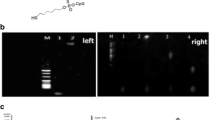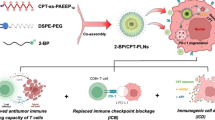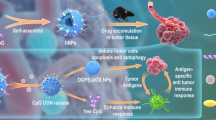Abstract
Considering the potent immune stimulation by CpG oligodeoxynucleotides (CpGs), the development of CpG carriers is a prerequisite for efficient cancer immunotherapy. In this study, we conjugated 1,2-distearoyl-sn-glycero-3-phosphoethanolamine-N-[hydroxyl succinimidyl (polyethylene glycol)] (DSPE-PEG-NHS) with polyethylenimine (PEI) to develop a PEI-PEG-DSPE conjugate that can serve as a biocompatible and efficient CpG carrier. Five types of PEIPEG-DSPE conjugates were developed, each with different molecular weights of PEI and different degrees of DSPEPEG modification, and all exhibited significantly lower cytotoxicity. In particular, compared to CpG delivery via natural PEI, delivery with PEI (25 kDa)-PEG-DSPE and DSPE-PEG-NHS/(amine groups of PEI) at a molar ratio of 0.1 resulted in a higher uptake of CpGs into RAW264.7 cells, probably because of the presence of a hydrophobic lipid moiety. In addition, PEI-PEG-DSPE/CpG complexes triggered significant cytokine secretion (TNF-α) from RAW264.7 cells, comparable to that triggered by PEI/CpG complexes. Thus, PEI-PEG-DSPE conjugates could serve as biocompatible and efficient carriers of the immune stimulator CpG to the macrophages.
Similar content being viewed by others
References
Hanagata, N. (2017) CpG oligodeoxynucleotide nanomedicines for the prophylaxis or treatment of cancers, infectious diseases, and allergies. Int. J. Nanomedicine. 12: 515–531.
Shirota, H., D. Tross, and D. M. Klinman (2015) CpG oligonucleotides as cancer vaccine adjuvants. Vaccines (Basel). 3: 390–407.
Ozcan, G., B. Ozpolat, R. L. Coleman, A. K. Sood, and G. Lopez-Berestein (2015) Preclinical and clinical development of siRNAbased therapeutics. Adv. Drug Deliv. Rev. 87: 108–119.
Hemmi, H., O. Takeuchi, T. Kawai, T. Kaisho, S. Sato, H. Sanjo, M. Matsumoto, K. Hoshino, H. Wagner, K. Takeda, and S. Akira (2000) A toll-like receptor recognizes bacterial DNA. Nature. 408: 740–745.
Zhang, H. and X. D. Gao (2017) Nanodelivery systems for enhancing the immunostimulatory effect of CpG oligodeoxynucleotides. Mater. Sci. Eng. C. Mater. Biol. Appl. 70: 935–946.
Hanagata, N. (2012) Structure-dependent immunostimulatory effect of CpG oligodeoxynucleotides and their delivery system. Int. J. Nanomedicine. 7: 2181–2195.
Chuang, Y. C., J. C. Tseng, L. R. Huang, C. M. Huang, C. Y. F. Huang, and T. H. Chuang (2020) Adjuvant effect of toll-like receptor 9 activation on cancer immunotherapy using checkpoint blockade. Front. Immunol. 11: 1075.
Reilley, M. J., B. Morrow, C. R. Ager, A. Liu, D. S. Hong, and M. A. Curran (2019) TLR9 activation cooperates with T cell checkpoint blockade to regress poorly immunogenic melanoma. J. Immunother. Cancer. 7: 323.
Buss, C. G. and S. N. Bhatia (2020) Nanoparticle delivery of immunostimulatory oligonucleotides enhances response to checkpoint inhibitor therapeutics. Proc. Natl. Acad. Sci. USA. 117: 13428–13436.
Hsu, C. Y. M. and H. Uludag (2012) Nucleic-acid based gene therapeutics: delivery challenges and modular design of nonviral gene carriers and expression cassettes to overcome intracellular barriers for sustained targeted expression. J. Drug Target. 20: 301–328.
Rattanakiat, S., M. Nishikawa, and Y. Takakura (2012) Selfassembling CpG DNA nanoparticles for efficient antigen delivery and immunostimulation. Eur. J. Pharm. Sci. 47: 352–358.
Jung, H., D. Kim, Y. Y. Kang, H. Kim, J. B. Lee, and H. Mok (2018) CpG incorporated DNA microparticles for elevated immune stimulation for antigen presenting cells. RSC Adv. 8: 6608–6615.
Jang, H. E., H. Jung, and H. Mok (2017) Cleavable conjugation of CpG oligodeoxynucleotides onto microparticles for facile release and cytokine induction in macrophages. Appl. Biol. Chem. 60: 321–326.
Kim, H. and W. J. Rhee (2020) Exosome-mediated let7c-5p delivery for breast cancer therapeutic development. Biotechnol. Bioprocess Eng. 25: 513–520.
Kim, S. H., Y. C. Ryu, H. M. D. Wang, and B. H. Hwang (2020) Optimally fabricated chitosan particles containing ovalbumin induced cellular and humoral immunity in immunized mice. Biotechnol. Bioprocess Eng. 25: 681–689.
Bae, C. S., C. M. Lee, and T. Ahn (2020) Encapsulation of apoptotic proteins in lipid nanoparticles to induce death of cancer cells. Biotechnol. Bioprocess Eng. 25: 264–271.
Cheng, T., J. Miao, D. Kai, and H. Zhang (2018) Polyethyleniminemediated CpG oligodeoxynucleotide delivery stimulates bifurcated cytokine induction. ACS Biomater. Sci. Eng. 4: 1013–1018.
Moghimi, S. M., P. Symonds, J. C. Murray, A. C. Hunter, G. Debska, and A. Szewczyk (2005) A two-stage poly(ethylenimine)-mediated cytotoxicity: implications for gene transfer/therapy. Mol. Ther. 11: 990–995.
Pandey, A. P. and K. K. Sawant (2016) Polyethylenimine: A versatile, multifunctional non-viral vector for nucleic acid delivery. Mater. Sci. Eng. C. Mater. Biol. Appl. 68: 904–918.
Florea, B. I., C. Meaney, H. E. Junginger, and G. Borchard (2002) Transfection efficiency and toxicity of polyethylenimine in differentiated Calu-3 and nondifferentiated COS-1 cell cultures. AAPS PharmSci. 4: E12.
Wang, J., F. Meng, B. K. Kim, X. Ke, and Y. Yeo (2019) In-vitro and in-vivo difference in gene delivery by lithocholic acidpolyethyleneimine conjugate. Biomaterials. 217: 119296.
Ngamcherdtrakul, W., T. Sangvanich, M. Reda, S. Gu, D. Bejan, and W. Yantasee (2018) Lyophilization and stability of antibodyconjugated mesoporous silica nanoparticle with cationic polymer and PEG for siRNA delivery. Int. J. Nanomedicine. 13: 4015–4027.
Liu, Z., Z. Zhang, C. Zhou, and Y. Jiao (2010) Hydrophobic modifications of cationic polymers for gene delivery. Prog. Polym. Sci. 35: 1144–1162.
Navarro, G., R. R. Sawant, S. Biswas, S. Essex, C. Tros de Ilarduya, and V. P. Torchilin (2012) P-glycoprotein silencing with siRNA delivered by DOPE-modified PEI overcomes doxorubicin resistance in breast cancer cells. Nanomedicine. 7: 65–78.
Bajaj, A., P. Kondaiah, and S. Bhattacharya (2008) Synthesis and gene transfection efficacies of PEI-cholesterol-based lipopolymers. Bioconjug Chem. 19: 1640–1651.
Cheon, S. H., Z. H. Kim, H. Y. Choi, S. H. Kang, H. J. Nam, J. Y. Kim, and D. I. Kim (2017) Effective delivery of siRNA to transgenic rice cells for enhanced transfection using PEI-based polyplexes. Biotechnol. Bioprocess Eng. 22: 577–585.
Dube, B., A. Pandey, G. Joshi, and K. Sawant (2017) Hydrophobically modified polyethylenimine-based ternary complexes for targeting brain tumor: stability, in vitro and in vivo studies. Artif. Cells. Nanomed. Biotechnol. 45: 1685–1698.
Forcato, D. O., A. E. Fili, F. E. Alustiza, J. M. Läzaro Martínez, S. Bongiovanni Abel, M. F. Olmos Nicotra, A. P. Alessio, N. Rodríguez, C. Barbero, and P. Bosch (2017) Transfection of bovine fetal fibroblast with polyethylenimine (PEI) nanoparticles: effect of particle size and presence of fetal bovine serum on transgene delivery and cytotoxicity. Cytotechnology. 69: 655–665.
Chen, H. C., B. Sun, K. K. Tran, and H. Shen (2011) Effects of particle size on toll-like receptor 9-mediated cytokine profiles. Biomaterials. 32: 1731–1737.
Bordelon, H., A. S. Biris, C. M. Sabliov, and W. T. Monroe (2011) Characterization of plasmid DNA location within chitosan/PLGA/pDNA nanoparticle complexes designed for gene delivery. J. Nanomater. 2011: 952060.
Kafil, V. and Y. Omidi (2011) Cytotoxic impacts of linear and branched polyethylenimine nanostructures in a431 cells. BioImpacts. 1: 23–30.
Wang, M., B. Wu, J. D. Tucker, P. Lu, and Q. Lu (2016) Poly(ester amine) constructed from polyethylenimine and pluronic for gene delivery in vitro and in vivo. Drug Deliv. 23: 3224–3233.
Yang, S., D. Wang, Y. Sun, and B. Zheng (2019) Delivery of antisense oligonucleotide using polyethylenimine-based lipid nanoparticle modified with cell penetrating peptide. Drug Deliv. 26: 965–974.
Navarro, G., R. R. Sawant, S. Essex, C. Tros de Ilarduya, and V. P. Torchilin (2011) Phospholipid-polyethylenimine conjugatebased micelle-like nanoparticles for siRNA delivery. Drug Deliv. Transl. Res. 1: 25–33.
Hong, J., S. H. Ku, M. S. Lee, J. H. Jeong, H. Mok, D. Choi, and S. H. Kim (2014) Cardiac RNAi therapy using RAGE siRNA/deoxycholic acid-modified polyethylenimine complexes for myocardial infarction. Biomaterials. 35: 7562–7573.
Josephs, S. F., T. E. Ichim, S. M. Prince, S. Kesari, F. M. Marincola, A. R. Escobedo, and A. Jafri (2018) Unleashing endogenous TNF-alpha as a cancer immunotherapeutic. J. Transl. Med. 16: 242.
Wang, J., J. Li, N. Wang, Q. Ji, M. Li, Y. Nan, E. M. Zhou, Y. Zhang, and C. Wu (2019) The 40 kDa linear polyethylenimine inhibits porcine reproductive and respiratory syndrome virus infection by blocking its attachment to permissive cells. Viruses. 11: 876.
Vancha, A. R., S. Govindaraju, K. V. L. Parsa, M. Jasti, M. Gonzälez-García, and R. P. Ballestero (2004) Use of polyethyleneimine polymer in cell culture as attachment factor and lipofection enhancer. BMC Biotechnol. 4: 23.
Zhao, M., M. Li, Z. Zhang, T. Gong, and X. Sun (2016) Induction of HIV-1 gag specific immune responses by cationic micelles mediated delivery of gag mRNA. Drug Deliv. 23: 2596–2607.
Acknowledgements
This study was supported by a grant (NRF- 2020R1A2B 5B01001677) from the National Research Foundation funded by the Ministry of Education, Science, and Technology. The authors declare no conflicts of interest. Neither ethical approval nor informed consent was required for this study.
Author information
Authors and Affiliations
Corresponding author
Additional information
Publisher’s Note
Springer Nature remains neutral with regard to jurisdictional claims in published maps and institutional affiliations.
Rights and permissions
About this article
Cite this article
Yang, J., Choi, E.S., You, G. et al. Evaluation of Lipid-polyethylenimine Conjugates as Biocompatible Carriers of CpG Oligodeoxynucleotides to Macrophages. Biotechnol Bioproc E 26, 586–594 (2021). https://doi.org/10.1007/s12257-020-0366-1
Received:
Revised:
Accepted:
Published:
Issue Date:
DOI: https://doi.org/10.1007/s12257-020-0366-1




